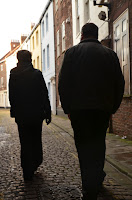Lighting plays a massive role in these images, contributing to the feel and disposition.
Keeping the images subtle but delivering clout is my purpose with my images. Like Hunter who earns much clarity in his work, and is slick and clever without being obvious, is the kind of image making I wanted to achieve.
Taking inspiration from Colin Gray and Tom Hunter I have produced a small series of photographs using narrative to communicate a story.
I took from Gray the use of presenting images in a sequence. This is reminiscent of reading a novel, which I have attempted to recreate with my own images. I decided to exhibit them in a series of three, to illustrate a beginning, middle and an end.
Alike to Hunter who uses elementary archetypes to achieve structured images which often reveal a very despondent and true account of everyday life, I have taken inspiration from music and applied my own interpretation. For example, the images below relate to the song ‘Heaven Can Wait’ by Charlotte Gainsbourg (which I highly recommend listening too).
Please observe and consider the images and let me know what conclusion you draw from them. I’ll be interested to know your thoughts…


